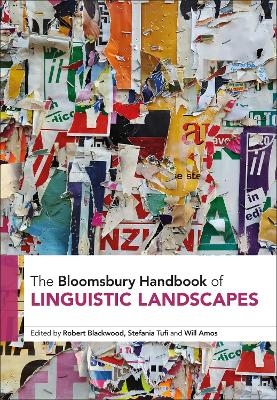
The Bloomsbury Handbook of Linguistic Landscapes
Bloomsbury Academic (Verlag)
978-1-350-27251-4 (ISBN)
Providing a thorough synopsis of the theories, methodologies, and objects of study which inflect linguistic landscape research across the world, this book is the ideal companion for both new and experienced readers interested in the processes of communication in public spaces across diverse settings and from a broad range of perspectives. Through a wide selection of case studies and original research, the handbook highlights the global reach of linguistic landscape theories and practices. Scrutinising an array of qualitative, quantitative, and mixed methodological approaches for analysing a wide spectrum of meaning-making phenomena, it investigates semiosis in contexts ranging from graffiti and street signs to tattoos and literature, visible across a variety of sites, including city centres, rural settings, schools, protest marches, museums, war-torn landscapes, and the internet.
Robert Blackwood is Professor of French Sociolinguistics at the University of Liverpool, UK, co-editor of the journal Linguistic Landscape, co-editor of Multilingual Memories (Bloomsbury Academic, 2020) and co-author of The Linguistic Landscape of the Mediterranean (2015). Stefania Tufi is Professor of Italian Studies and Sociolinguistics at the University of Liverpool, UK. Will Amos is Associate Professor in Translation and Transcultural Studies at the University of Warwick, UK.
List of Figures
List of Tables
List of Contributors
1. Introduction, Robert Blackwood (University of Liverpool, UK), Stefania Tufi (University of Liverpool, UK) and Will Amos
2. Linguistic Landscapes, Bernard Spolsky (University of Warwick, UK)
Part I: Approaches and Methods
3. Qualitative Methods, Mooniq Shaikjee (University Of The Western Cape, South Africa) , Sibonile Mpendukana (University of Cape Town, South Africa) and Christopher Stroud (Stockholm University, Sweden)
4. Quantitative Methods, Barbara Soukup (University of Vienna, Austria) and Kate Lyons (University Of Illinois at Urbana-Champaign, USA)
5. Videography, Robert A. Troyer (Western Oregon University, USA) and Tamás P. Szabó (University Of Jyväskylä, Finland)
6. Digital Approaches, Christoph Purschke (University Of Luxembourg, Luxembourg)
Part II: Contemporary Areas for Research
7. Affect, Rebecca Todd Garvin (Martin Methodist College, USA)
8. Art, Yael Guilat (Oranim College, Israel) and Shoshi Waksman (Tel Aviv University, Israel)
9. Bodies and Skinscapes, Amiena Peck (University of the Western Cape, South Africa)
10. Borderscapes, Stefania Tufi (University of Liverpool, UK)
11. The City, Alastair Pennycook(University of Technology Sydney, Australia)
12. Education, Durk Gorter and Jasone Cenoz (University of the Basque Country, Spain)
13. Ethnic Spaces, Jackie Jia Lou (Birkbeck University of London, UK)
14. Extreme Landscapes, Fiona McLaughlin (University of Florida, USA) and Karim Ouaras (Oran University, Algeria)
15. Gender and Sexuality, Rodrigo Borba (Federal University of Rio de Janeiro, Brazil) and Mie Hiramoto (National University of Singapore, Singapore)
16. Language Learning, David Malinowski (San José State University, USA)
17. Language Policy, Sanita Martena (Rezekne Academy of Technologies, Latvia) and Heiko Marten (Rezekne Academy of Technologies, Latvia)
18. Linguistic Awareness, Rights and Activism, Elana Shohamy (Tel Aviv University, Israel)
19. Minority Languages, Deirdre A. Dunlevy (Trinity College Dublin)
20. Memorialization, Robert Blackwood (University of Liverpool, UK) and John Macalister (Victoria University Wellington, New Zealand)
21. Multilingualism, Marián Sloboda (Charles University, Prague)
22. Protest and Dissent, Will Amos (University of Warwick, UK)
23. The Rural, Hambaba Jimaima (University of Zambia, Zambia)
24. Touring Warscapes, Maida Kosatica (University of Bern, Switzerland)
25. Tourism, Gavin Lamb (University of Oslo, Norway) and Bal Krishna Sharma (University of Idaho, USA)
Part III: Future Directions in Linguistic Landscapes
26. Literature and the Creative Arts, Charles Forsdick (University of Liverpool, UK)
27. Familyscapes, Kellie Gonçalves (University of Cologne, Germany) and Elizabeth Lanza (University of Oslo, Norway)
28. The Offline-Online Nexus, Jannis Androutsopoulos (University of Hamburg, Germany & University of Oslo, Norway)
29. Settler Colonialism and Acts of Decoloniality, David Kroik, Kaisa Huuva and Tommaso Milani (Stockholm University, Sweden)
Index
| Erscheinungsdatum | 08.08.2024 |
|---|---|
| Reihe/Serie | Bloomsbury Handbooks |
| Zusatzinfo | 100 bw illus |
| Verlagsort | London |
| Sprache | englisch |
| Maße | 169 x 244 mm |
| Themenwelt | Geisteswissenschaften ► Philosophie ► Erkenntnistheorie / Wissenschaftstheorie |
| Geisteswissenschaften ► Sprach- / Literaturwissenschaft ► Sprachwissenschaft | |
| Sozialwissenschaften | |
| ISBN-10 | 1-350-27251-5 / 1350272515 |
| ISBN-13 | 978-1-350-27251-4 / 9781350272514 |
| Zustand | Neuware |
| Haben Sie eine Frage zum Produkt? |
aus dem Bereich


![Was heißt Denken?. Vorlesung Wintersemester 1951/52. [Was bedeutet das alles?] - Martin Heidegger](/media/113619842)